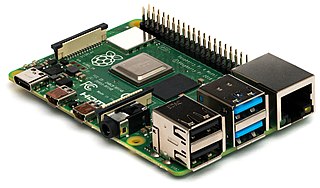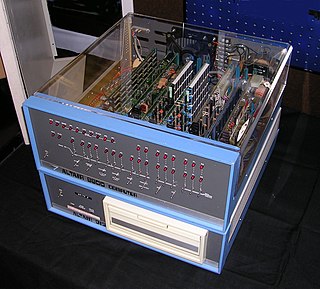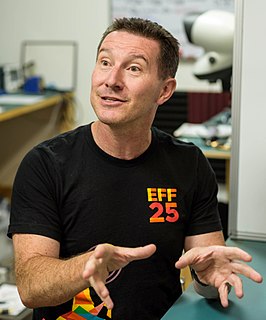
The 6800 is an 8-bit microprocessor designed and first manufactured by Motorola in 1974. The MC6800 microprocessor was part of the M6800 Microcomputer System that also included serial and parallel interface ICs, RAM, ROM and other support chips. A significant design feature was that the M6800 family of ICs required only a single five-volt power supply at a time when most other microprocessors required three voltages. The M6800 Microcomputer System was announced in March 1974 and was in full production by the end of that year.

A microcomputer is a small, relatively inexpensive computer with a microprocessor as its central processing unit (CPU). It includes a microprocessor, memory and minimal input/output (I/O) circuitry mounted on a single printed circuit board (PCB). Microcomputers became popular in the 1970s and 1980s with the advent of increasingly powerful microprocessors. The predecessors to these computers, mainframes and minicomputers, were comparatively much larger and more expensive. Many microcomputers are also personal computers.

The Altair 8800 is a microcomputer designed in 1974 by MITS and based on the Intel 8080 CPU. Interest grew quickly after it was featured on the cover of the January 1975 issue of Popular Electronics and was sold by mail order through advertisements there, in Radio-Electronics, and in other hobbyist magazines. The Altair is widely recognized as the spark that ignited the microcomputer revolution as the first commercially successful personal computer. The computer bus designed for the Altair was to become a de facto standard in the form of the S-100 bus, and the first programming language for the machine was Microsoft's founding product, Altair BASIC.
The Open Letter to Hobbyists is a 1976 open letter written by Bill Gates, the co-founder of Microsoft, to early personal computer hobbyists, in which Gates expresses dismay at the rampant software piracy taking place in the hobbyist community, particularly with regard to his company's software.
Micro Instrumentation and Telemetry Systems (MITS) was an American electronics company founded in Albuquerque, New Mexico that began manufacturing electronic calculators in 1971 and personal computers in 1975.

Popular Electronics was an American magazine published by John August Media, LLC, and hosted at TechnicaCuriosa.com. The magazine was started by Ziff-Davis Publishing Company in October 1954 for electronics hobbyists and experimenters. It soon became the "World's Largest-Selling Electronics Magazine". In April 1957 Ziff-Davis reported an average net paid circulation of 240,151 copies. Popular Electronics was published until October 1982 when, in November 1982, Ziff-Davis launched a successor magazine, Computers & Electronics. During its last year of publication by Ziff-Davis, Popular Electronics reported an average monthly circulation of 409,344 copies. The title was sold to Gernsback Publications, and their Hands-On Electronics magazine was renamed to Popular Electronics in February 1989, and published until December 1999. The Popular Electronics trademark was then acquired by John August Media, who revived the magazine, the digital edition of which is hosted at TechnicaCuriosa.com, along with sister titles, Mechanix Illustrated and Popular Astronomy.

Dick Smith Holdings Limited was an Australian chain of retail stores that sold consumer electronics goods, hobbyist electronic components, and electronic project kits. The chain expanded successfully into New Zealand and unsuccessfully into several other countries. The company was founded in Sydney in 1968 by Dick Smith and owned by him and his wife until they sold 60% to Woolworths Limited in 1980, the remaining 40% two years later. The company closed its stores in 2016, four years after its acquisition by Anchorage Capital Partners.

Forrest M. Mims III is an American amateur scientist, magazine columnist, and author of Getting Started in Electronics and Engineer's Mini-Notebook series of instructional books that were originally sold in Radio Shack electronics stores. Mims graduated from Texas A&M University in 1966 with a major in government and minors in English and history. He became a commissioned officer in the United States Air Force.

Henry Edward "Ed" Roberts was an American engineer, entrepreneur and medical doctor who invented the first commercially successful personal computer in 1974. He is most often known as "the father of the personal computer." He founded Micro Instrumentation and Telemetry Systems (MITS) in 1970 to sell electronics kits to model rocketry hobbyists, but the first successful product was an electronic calculator kit that was featured on the cover of the November 1971 issue of Popular Electronics. The calculators were very successful and sales topped one million dollars in 1973. A brutal calculator price war left the company deeply in debt by 1974. Roberts then developed the Altair 8800 personal computer that used the new Intel 8080 microprocessor. This was featured on the cover of the January 1975 issue of Popular Electronics, and hobbyists flooded MITS with orders for this $397 computer kit.

Daniel Meyer was the founder and president Southwest Technical Products Corporation. He was born in New Braunfels, Texas and raised in San Marcos, Texas where he earned a bachelor's degree in mathematics and physics in 1957 from Southwest Texas State. After college he married Helen Wentz, moved to San Antonio and became a research engineer in the electrical engineering department of Southwest Research Institute.
Parallax Inc. is a privately held company in Rocklin, California. Parallax Inc. designs, manufactures, and sells BASIC Stamp microcontrollers, Propeller microcontrollers, microcontroller accessories, educational robot kits, and educational curriculum.

Silicon Chip is an Australian electronics magazine. It was started in November, 1987 by Leo Simpson. Following the demise of Electronics Australia, for many years it was the only hobbyist-related electronics magazine remaining in Australia. A new competitor, called Diyode launched in July 2017.

Maplin Electronics is an online retailer of electronic goods in the United Kingdom and Ireland, based on the assets of the former company Maplin Electronic Supplies, which operated from 1972 to 2018. Prior to 2018, the original Maplin company operated an extensive online, telephone and mail order service. In June 2017, there were 217 Maplin stores.

The TV Typewriter was a video terminal that could display two pages of 16 lines of 32 upper case characters on a standard television set. The design, by Don Lancaster, appeared on the cover of Radio-Electronics magazine in September 1973.
Electronics Today International or ETI was a magazine for electronics hobbyists and professionals.

The TEC-1 is a single-board kit computer first produced by the Australian hobbyist electronics magazine Talking Electronics in the early 1980s. The design by John Hardy and Ken Stone was based on the Zilog Z80 CPU, had 2K of RAM and 2K of ROM in a default configuration. Later versions used a 4k ROM with two different versions of the monitor software selectable via a switch. This allowed the early software presented in the magazine to be used with the later version of the TEC-1.
Electronics Australia or EA was Australia's longest-running general electronics magazine. It was based in Chippendale, New South Wales.
Charles Platt is an author, journalist and computer programmer. He relocated from England to the United States during 1970 and is a naturalized U.S. citizen. He has one child, Rose Fox, who edits science-fiction, fantasy, and horror book reviews. Platt is the nephew of Robert Platt, Baron Platt of Grindleford.

David L. Jones is an Australian electronic design engineer and video blogger. He is the founder and host of EEVBlog, a blog and YouTube channel targeting electronics engineers, hobbyists, hackers, and makers. His content has been described as a combination of "in-depth equipment reviews and crazy antics".














